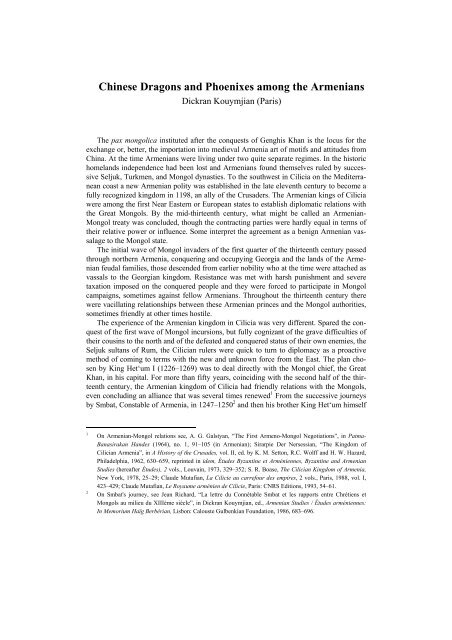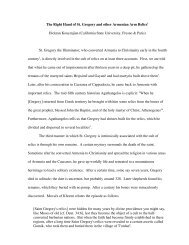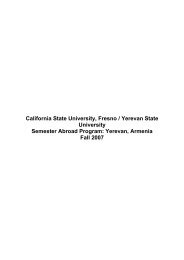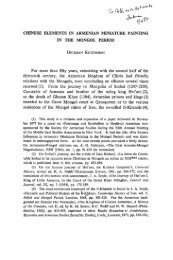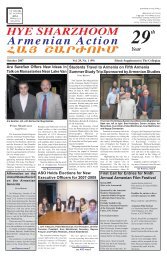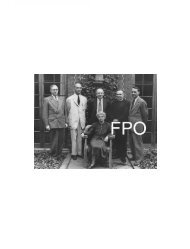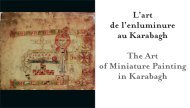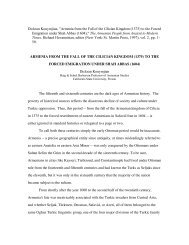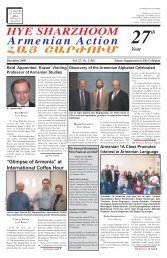Chinese Dragons and Phoenixes among the Armenians
Chinese Dragons and Phoenixes among the Armenians
Chinese Dragons and Phoenixes among the Armenians
You also want an ePaper? Increase the reach of your titles
YUMPU automatically turns print PDFs into web optimized ePapers that Google loves.
4Dickran Kouymjian(fig. 1) displays a wide, richly decorated b<strong>and</strong> tapering toward a central round frame decoratedwith a symmetrical scroll of fleur-de-lys in which is a beardless bust of <strong>the</strong> youthfulChrist Emmanuel against a plain gold background, a common feature of twelfth <strong>and</strong> thirteenthcentury Cilician Armenian manuscripts. 13On each side of Christ are grey-brown, <strong>Chinese</strong> inspired lions in an upright positionprancing toward <strong>the</strong> central circle but with <strong>the</strong>ir heads turned forward <strong>and</strong> with eyes slightlyaskance toward Christ. Each animal's mouth <strong>and</strong> nose is highly stylized forming a trilobedleaf motif. From <strong>the</strong> top of <strong>the</strong>ir heads, sharp, flame-like, tufts of hair point upward. Theirtails are knotted in <strong>the</strong> <strong>Chinese</strong> manner. 14 Lions were introduced into <strong>Chinese</strong> art along withBuddhism. Buddha was considered a lion <strong>among</strong> men. These felines are seen as symbols ofpower <strong>and</strong> protectors of temples or <strong>the</strong> images around which <strong>the</strong>y are placed. Just below <strong>the</strong>frame is ano<strong>the</strong>r pair of similar animals, bright blue in colour, crouching on all fours. Theydisplay <strong>the</strong> same tightly curled hair, bushy tails <strong>and</strong> ears, but somewhat different faces. Alate Tang or Liao Dynasty (907–1125) upright gilt bronze lion has a face <strong>and</strong> pug nose like<strong>the</strong>se animals, 15 <strong>and</strong> a Sung Dynasty (960–1279) ceramic with a seated lion scratching itsleft ear has similar curls <strong>and</strong> a trilobed nose. 16 The <strong>Chinese</strong> lions protect Christ frommenacing dragons of a non-Far Eastern type found at <strong>the</strong> extremities of <strong>the</strong> headpiece.There are also o<strong>the</strong>r items clearly inspired by <strong>Chinese</strong> art – various birds <strong>and</strong> a BuddhistWheel of <strong>the</strong> Law for instance; <strong>the</strong>se have been described <strong>and</strong> discussed in earlier articles. 17The second chapter heading (fig. 2), <strong>the</strong> lection for <strong>the</strong> feast of <strong>the</strong> Transfiguration,(Vardavar in Armenian), is less well known. 18 Its formal arrangement is similar to <strong>the</strong> o<strong>the</strong>r,again with a complex, vertical decoration along <strong>the</strong> entire right margin. The centre of <strong>the</strong>headpiece is an empty trilobed arch, whose flanking sp<strong>and</strong>rels are each filled with a confronteddragon <strong>and</strong> phoenix motif. From <strong>the</strong> viewer's position <strong>the</strong> dragons are given preference:<strong>the</strong>ir blue heads with white highlights are shown with open mouths, noses turned up,131415161718Kingdom of Cilicia, fig. 516. Earlier literature <strong>and</strong> reproductions: Arménag Sakissian, “Thèmes et motifsd'enluminure et de décoration arméniennes et musulmanes”, in Ars Islamica, vol. V1 (1939), 66–87, reprintedin idem, Pages d'art arménien, Paris, 1940, 59–86, fig. 38, references in this article is to Pages; Dournovo,Armenian Miniatures, 126–127; Dournovo / Drampyan, pl. 43; Azaryan, Cilician Miniature Painting, fig.134; Der Nersessian, “Miniatures ciliciennes”, in L'Oeil, no. 179 (November, 1969), 2–9, 110, fig. 22,reprinted in idem, Études, 509–515, fig. 261; John Beckwith, Early Christian <strong>and</strong> Byzantine Art,Harmondsworth, 1970, 139, pl. 259; Der Nersessian, Armenian Art, 155, fig. 116.The earliest Cilician manuscript with Christ Emmanuel (in <strong>the</strong> headpiece of <strong>the</strong> incipit of St. Mat<strong>the</strong>w) is froma Cilician Gospel book of 1166 copied by <strong>the</strong> scribe Kozma at Hromkla, Erevan, M7347, fol. 13; Der Nersessian,Miniature Painting in <strong>the</strong> Armenian Kingdom of Cilicia, 3–4, fig. 9, o<strong>the</strong>rs are discussed by her, see <strong>the</strong>index, 197.Discussion of <strong>the</strong> knotted tail in Masuya, “Ilkhanid Courtly Life”, Komaroff <strong>and</strong> Carboni, The Legacy ofGenghis Khan, 97 <strong>and</strong> Yol<strong>and</strong>a Crowe, “Late Thirteenth Century Persian Tileworks <strong>and</strong> <strong>Chinese</strong> Textiles”, inBulletin of <strong>the</strong> Asia Institute, n.s., vol. 5 (1991), 157.London, Victoria <strong>and</strong> Albert Museum, Mount Trust Collection of <strong>Chinese</strong> Art, London, 1970, 40, no. 42;Kouymjian, “<strong>Chinese</strong> Elements”, 434–5, fig. 4.Mario Pradan, La poterie T'ang, Paris, 1960, pl. 15; Kouymjian, “<strong>Chinese</strong> Elements”, 434, fig. 5.Kouymjian, “<strong>Chinese</strong> Elements”, 432–443; Kouymjian, “<strong>Chinese</strong> Motifs”, 311–314.Erevan, M979, fol. 334; Kouymjian, “<strong>Chinese</strong> Elements”, 437–433, figs. 3a–3d (with details); colour illustrationsin Dournovo, Ancient Armenian Miniature Paintings, Erevan, 1952, pl. 35; Emma Korkhmazian, IrinaDrampian, Hravard Hakopian, Armenian Miniatures of <strong>the</strong> 13 th <strong>and</strong> 14 th centuries, Leningrad, 1984, fig. 119;Der Nersessian, Miniature Painting in <strong>the</strong> Armenian Kingdom of Cilicia, fig. 517; see also Azaryan, CilicianMiniature Painting, fig. 134.
<strong>Chinese</strong> <strong>Dragons</strong> <strong>and</strong> <strong>Phoenixes</strong> <strong>among</strong> <strong>the</strong> <strong>Armenians</strong> 5both eyes visible <strong>and</strong> directed frontally. They have paws of four claws spread out like pinwheels.Confronting <strong>the</strong> dragons are phoenixes with brown bodies <strong>and</strong> heads <strong>and</strong> bluewings, <strong>the</strong> tips of which end in soft, pink, flared fea<strong>the</strong>rs. The birds are rendered verticallyby <strong>the</strong> requirements of <strong>the</strong> composition with <strong>the</strong>ir heads in profile, beaks open, pointeddirectly into <strong>the</strong> dragons' mouths. Their bodies, however, are spread out in aerial view. Thecharacteristic tails with long flowing flyers are reduced to short deep pink tufts (seen at <strong>the</strong>bottom of <strong>the</strong> sp<strong>and</strong>rels) probably due to <strong>the</strong> exigencies of space, though <strong>the</strong>re is a form of<strong>Chinese</strong> phoenix with a short tail but no long streamers. 19 Traditionally, historians of <strong>Chinese</strong>art maintain that <strong>the</strong> dragon <strong>and</strong> phoenix in combat or opposition does not occur in artuntil <strong>the</strong> Ming Dynasty (1368–1644). There is even <strong>the</strong> suggestion that <strong>the</strong>y do not appeartoge<strong>the</strong>r on <strong>the</strong> same object until <strong>the</strong>n. Thus, this late thirteenth century Armenian example,in which <strong>the</strong> animals are clearly confronted, is enigmatic. The meaning <strong>and</strong> interpretation of<strong>the</strong> dragon-phoenix pair within an aristocratic Christian manuscript will be considered indetail below.In <strong>the</strong> centre of <strong>the</strong> headpiece above <strong>the</strong> arch is a single <strong>Chinese</strong> phoenix placed inalmost an heraldic manner (fig. 2). Its colouring is <strong>the</strong> same as <strong>the</strong> o<strong>the</strong>rs. It is positionedalmost identically to phoenixes (fig. 4) described as “soaring” on two thirteenth-century JinDynasty (1115–1234) silks in <strong>the</strong> Clevel<strong>and</strong> Museum. 20 The head of <strong>the</strong> Armenian exampleis turned like those on <strong>the</strong> silks <strong>and</strong> <strong>the</strong> streaming tails are also turned, though one is hiddenunder its body. They are arranged symmetrically <strong>and</strong> are very long, winding down <strong>and</strong> <strong>the</strong>nlooping upward above <strong>the</strong> phoenix's spread wings. The whole bird is visible, revealing fine,soft, fury tufts of fea<strong>the</strong>rs <strong>and</strong>, on both sides at <strong>the</strong> back of <strong>the</strong> wings, additional pointedfea<strong>the</strong>rs reminiscent of <strong>the</strong> pointed flames on <strong>the</strong> lion manes of <strong>the</strong> earlier headpiece. Theentire form is rendered extremely gracefully with well-understood proportions. The rest of<strong>the</strong> decoration is similar to <strong>the</strong> o<strong>the</strong>r headpiece with East Asian elements such as rosettesthat represent <strong>the</strong> Buddhist Wheel of Law <strong>and</strong> a pair of deer. However, <strong>the</strong> vast majority ofdecorative elements in <strong>the</strong> decorative vertical b<strong>and</strong> to <strong>the</strong> right <strong>and</strong> elsewhere in <strong>the</strong> Lectionary(over 300 illuminations of various size) are not inspired by <strong>Chinese</strong> art <strong>and</strong> are notof concern to this study.Gospel of Archbishop JohnThe third miniature bearing a <strong>Chinese</strong> motif, in a Gospel manuscript executed forArchbishop John in 1289, has as its last miniature a donor portrait depicting <strong>the</strong> aged cleric1920Best illustrated in <strong>the</strong> large (143 x 135 cm) Yüan canopy with two phoenixes in <strong>the</strong> Metropolitan Museum ofArt (1988.82), James C. Y. Watt <strong>and</strong> Anne E. Wardwell, When Silk Was Gold: Central Asian <strong>and</strong> <strong>Chinese</strong>Textiles, New York: Metropolitan Museum of Art, 1997, no. 60, 196–199; Komaroff <strong>and</strong> Carboni, The Legacyof Genghis Khan, no. 184, 179, fig. 210, <strong>the</strong> phoenix on top, see also fig. 82, 196, in Watt <strong>and</strong> Wardwell,showing a Yüan relief carving with two phoenixes; <strong>the</strong> one lacking streamers is above. Jessica Rawson, <strong>Chinese</strong>Ornament: The Lotus <strong>and</strong> <strong>the</strong> Dragon, New York, 1984, 100, suggests that <strong>the</strong> difference in tail fea<strong>the</strong>rshas to do with <strong>the</strong> gender of <strong>the</strong> bird.Clevel<strong>and</strong> Museum of Art, John L. Severance Fund (1994.292), tabby, brocade, gold thread on a blue greenground with rows of phoenixes facing right <strong>and</strong> left, Watt <strong>and</strong> Wardwell, When Silk Was Gold, no. 31, 118–119; Komaroff <strong>and</strong> Carboni, The Legacy of Genghis Khan, no. 180, 197, fig. 207. Clevel<strong>and</strong> Museum of Art,Gift of <strong>the</strong> Art Textile Alliance (1994.27), tabby, brocade, Watt <strong>and</strong> Wardwell, no. 32, 120–121.
6Dickran Kouymjianperforming an ordination (fig. 3). 21 On <strong>the</strong> archbishop's tunic or alb, a liturgical garmentworn under <strong>the</strong> chasuble, <strong>the</strong>re is an isolated motif of a <strong>Chinese</strong> dragon woven in gold withred outlines. The head of <strong>the</strong> dragon is raised vertically in profile while <strong>the</strong> neck, body, <strong>and</strong>tail wind upward. The visible feet have each three claws. 22 In front of its open mouth is aleaf-like object, perhaps intended to be a flaming pearl. Perforce <strong>the</strong> silk was acquiredbefore 1289, also <strong>the</strong> date of Bishop John's death. 23 The textile in <strong>the</strong> miniature is a piece of<strong>Chinese</strong> silk used as an under garment, 24 but it is hard to say if <strong>the</strong> entire tunic was made of<strong>Chinese</strong> silk or if <strong>the</strong> dragon was just a piece sewn on its front. The dragon's resemblance toau<strong>the</strong>ntic <strong>Chinese</strong> silks is striking as is evident from two pieces: a splendid red silk of <strong>the</strong>Jin Dynasty (1115–1234) in <strong>the</strong> Metropolitan Museum of Art with rows of coiled goldendragons with five claws facing in different directions, 25 <strong>and</strong> a smaller fragment in <strong>the</strong>Clevel<strong>and</strong> Museum of Art dated to <strong>the</strong> contemporary Mongol Yüan Dynasty (1279–1368)2122232425Erevan, M197, fol. 141v, not executed at <strong>the</strong> monastery of Akner as believed by some authorities; see DerNersessian, Miniature Painting in <strong>the</strong> Armenian Kingdom of Cilicia, 96–97; Kouymjian, “<strong>Chinese</strong> Elements”,418–419, figs. 1a–1b (detail of dragon); colour reproductions in Mutafian, Le Royaume arménien de Cilicie,55; Der Nersessian, ibid., fig. 645.When I first studied this miniature, I thought I saw four claws, but today what I thought was a fourth claw,especially on <strong>the</strong> right front leg may be a leaf. The hind legs or feet show three claws. As bro<strong>the</strong>r of KingHet‘um, <strong>the</strong> number three would place him in <strong>the</strong> proper subordinate rank of a prince, on which question seebelow.John wears a chasuble decorated with four-pointed stars in gold (intended as stylized crosses with arms ofequal length?) on a red ground. The shape is similar to “cross“ tiles, as <strong>the</strong>y are called, from Takht-i Sulaymān,Komaroff <strong>and</strong> Carboni, The Legacy of Genghis Khan, 175, fig. 204, 237, fig. 278; Kouymjian “<strong>Chinese</strong>Elements”, 448, fig. 14, after a reconstruction of eight pointed dragon <strong>and</strong> phoenix tiles with cross tiles proposedby Elizabeth <strong>and</strong> Rudolf Naumann, “Ein Kösk in Summerpalast des Abaqa Khan auf dem Tacht-iSulaiman und seine Dekoration”, in Forschungen für Kunst asians. In Memorium Kurt Erdmann, Istanbul,1969, fig. 11; Komaroff <strong>and</strong> Carboni, The Legacy of Genghis Khan, 176, fig. 205. Might this suggest that <strong>the</strong>chasuble was woven in Ilkhanid Iran?S. Der Nersessian, L'Art arménien, Paris, 1977; English edition Armenian Art, London, 1978, 160, “An exampleof […] imported silk clo<strong>the</strong>s exists in <strong>the</strong> portrait of Archbishop John […] adorned with a <strong>Chinese</strong> dragon[…] sewn onto <strong>the</strong> bottom of his cope”; colour illustrations in Mutafian, Le Royaume Arménien de Cilicie, 55;Der Nersessian, Miniature Painting in <strong>the</strong> Armenian Kingdom of Cilicia, fig. 645. Der Nersessian has spokenof this fabric more than once, “Deux exemples arméniens de la Vierge de Miséricorde”, in Revue des étudesarméniennes, n.s., vol. 7 (1970), 187–202, reprinted in idem, Études Byzantines et Arméniennes, 595, “Jean,i.e. Bishop John] semble avoir eu une predilection pour les beaux tissue car dans son portrait de l'an 1287 [sic]il porte, sous la chasuble, une tunique de soi chinoise ornée de motif caractéristique du dragon”; MiniaturePainting in <strong>the</strong> Armenian Kingdom of Cilicia, 158, “The material of Archbishop John's alb […] came from anentirely different region. A gold dragon, st<strong>and</strong>ing upright with gaping jaws, is woven on white ground; <strong>the</strong>gold has flaked from <strong>the</strong> greater part of <strong>the</strong> foliate ornament around <strong>the</strong> dragon. […] I believe that we do nothave an imitation of <strong>Chinese</strong> ornament, but an actual textile like <strong>the</strong> Italian material of <strong>the</strong> chasuble [in <strong>the</strong>miniature of 1274] […] <strong>Chinese</strong> silk might have been brought by one of John's bro<strong>the</strong>rs […] both of whomhad visited <strong>the</strong> Mongol court, or it may have been an imported silk that Bishop John could have used as hisalb.”New York, MMA, 1989–205, 74.5x33.2 cm; first published in Watt <strong>and</strong> Wardwell, When Silk Was Gold, no.30, 116–7; Komaroff <strong>and</strong> Carboni, The Legacy of Genghis Khan, cat. 181, 174, fig. 202.
<strong>Chinese</strong> <strong>Dragons</strong> <strong>and</strong> <strong>Phoenixes</strong> <strong>among</strong> <strong>the</strong> <strong>Armenians</strong> 7depicting rows of golden dragons in a nearly identical coiled position with three clawswithin roundels. 26John, as <strong>the</strong> bro<strong>the</strong>r of King Het‘um I <strong>and</strong> Smbat <strong>the</strong> Constable, both of whom had beenreceived by <strong>the</strong> Mongol Khans at Kharakhorum, may have acquired this <strong>Chinese</strong> silk as agift from one of <strong>the</strong>m. Yet, in three earlier portraits in manuscripts also commissioned byhim, he is wearing different robes without any clear traces of Far Eastern design. 27Thus, we see on <strong>the</strong>se three folios from two Armenian manuscripts copied for <strong>the</strong> royalfamily three years apart, a group of figures which seem to be copied with almost no modificationfrom <strong>Chinese</strong> models. In addition to <strong>the</strong> guardian lions <strong>the</strong>y include <strong>the</strong> dragonphoenixmotif, <strong>the</strong> heraldic phoenix, <strong>and</strong> <strong>the</strong> single dragon on Archbishop John’s garment.In <strong>the</strong> latter case, we are confronted by a faithfully copied piece of <strong>Chinese</strong> gold wovensilk, 28 while <strong>the</strong> single phoenix in <strong>the</strong> second headpiece is rendered in such a way that it toomust have been copied from Jin or Yüan silks. The dragon-phoenix motif is well knownfrom <strong>Chinese</strong> textiles, 29 including honorary robes, ceramics, bronze mirrors, <strong>and</strong> later Minglacquers.The Armenian Miniatures <strong>and</strong> <strong>the</strong> Tiles of Takht-i SulaymānDespite <strong>the</strong> difference in medium, <strong>the</strong> painted Armenian dragons <strong>and</strong> phoenixes resemblethose on <strong>the</strong> tiles (fig. 5) from <strong>the</strong> Ilkhanid summer palace at Takht-i Sulaymān. 30 Their2627282930Clevel<strong>and</strong> Museum of Art (Edward I. Whittemore Fund, 1995–73), 20 cm square, with alternating rows ofroundels with phoenixes (only partially visible on <strong>the</strong> fragment) <strong>and</strong> dragons; Watt <strong>and</strong> Wardwell, When SilkWas Gold, no. 42, 153; Komaroff <strong>and</strong> Carboni, The Legacy of Genghis Khan, cat. 183, fig. 206, 176.Each of <strong>the</strong>se are discussed in detail in Kouymjian, “<strong>Chinese</strong> Motifs”, 310–311.It is less likely a fabric produced in Armenia with a <strong>Chinese</strong> motif, though Armenia was known for its finetextile industry <strong>and</strong> contemporary miniatures display <strong>the</strong> rich apparel worn by Armenian aristocracy, no doubtsome imported from east <strong>and</strong> west. A manuscript of 1268–9, attributed to T‘oros Roslin, in <strong>the</strong> Freer Galleryof Art, Washington, D.C., FGA 32.18, 535, shows Christ wearing such a garment when he appears to <strong>the</strong> Disciplesafter <strong>the</strong> Resurrection, Der Nersessian, Armenian Manuscripts in <strong>the</strong> Freer Gallery of Art, Washington,1963, fig. 165, colour reproduction in idem, Armenian Art, 135, fig. 98. There are many o<strong>the</strong>r such examples,as in <strong>the</strong> costumes of Prince Levon <strong>and</strong> Princess Keran, a manuscript executed in 1262 at Hromkla by T‘orosRoslin, Jerusalem, Armenian Patriarchate, J2660, fol. 228, for colour illustration see, [C. F. J. Dowsett],Catalogue of Twenty-three Important Armenian Illuminated Manuscripts, London: So<strong>the</strong>by's, 1967, lot no. 1,Der Nersessian, Miniature Painting in <strong>the</strong> Armenian Kingdom of Cilicia, fig. 640; or in ano<strong>the</strong>r portrait of <strong>the</strong>same Leo <strong>and</strong> Keran, now king <strong>and</strong> queen, <strong>and</strong> <strong>the</strong>ir children being blessed by Christ flanked by <strong>the</strong> Virgin<strong>and</strong> John <strong>the</strong> Baptist in a Gospel of 1272 copied by <strong>the</strong> scribe Avetis probably in <strong>the</strong> Cilician capital Sis, Jerusalem,Armenian Patriarchate, J2563, fol. 380; Der Nersessian, ibid., fig. 641,A silk lampas fragment from <strong>the</strong> Yüan Dynasty (1279–1368) acquired in 1995 by <strong>the</strong> Clevel<strong>and</strong> Museum ofArt (Edward I. Whittemore Fund, 1995–73), 20 cm square, shows <strong>the</strong> dragons <strong>and</strong> phoenixes individuallywoven in roundels in gold on a dark green-black ground, Watt <strong>and</strong> Wardwell, When Silk Was Gold, no. 42,153; Komaroff <strong>and</strong> Carboni, The Legacy of Genghis Khan, no. 183, 176–177, fig. 206.The closest in feeling are on <strong>the</strong> large lustre titles, both dragons <strong>and</strong> phoenixes, but never toge<strong>the</strong>r on <strong>the</strong> sametile, <strong>and</strong> for <strong>the</strong> phoenix <strong>the</strong> eight-pointed star tiles in lajvardina; Komaroff <strong>and</strong> Carboni, The Legacy of GenghisKhan, no. 99, fig. 97 dragon from <strong>the</strong> Metropolitan Museum of Art, no. 100, fig. 100, phoenix from <strong>the</strong>Victoria <strong>and</strong> Albert Museum, no. 84, fig. 101, star tiles from Arthur M. Sackler Gallery, Washington, or <strong>the</strong>phoenix on a hexagonal tile from Berlin, no. 103, fig. 95. During <strong>the</strong> exhibition “The Legacy of GenghisKhan” (2003) at <strong>the</strong> Los Angeles County Museum of Art, Linda Komaroff <strong>and</strong> her staff set up an entire wallof <strong>the</strong>se tiles or <strong>the</strong>ir reproductions mixing dragon <strong>and</strong> phoenix tiles somewhat like <strong>the</strong> reconstruction on
8Dickran Kouymjiansource was surely <strong>the</strong> same: China, ei<strong>the</strong>r directly or through <strong>the</strong> Mongol courts in CentralAsia. The possibility that East Asian craftsmen actually were in part responsible for <strong>the</strong>Ilkhanid ceramics has no echo in <strong>the</strong> Armenian experience. 31 Whe<strong>the</strong>r we speak of <strong>the</strong>1270s or 1280s or even <strong>the</strong> 1290s, <strong>the</strong> only au<strong>the</strong>ntic <strong>Chinese</strong> looking dragons <strong>and</strong> phoenixesin <strong>the</strong> art of <strong>the</strong> Near East before 1300 are <strong>the</strong> Armenian ones <strong>and</strong> those on <strong>the</strong> TakhtiSulaymān tiles, along with <strong>the</strong> monumental dragon carved at <strong>the</strong> neighbouring site ofViar, dated, like <strong>the</strong> tiles, to <strong>the</strong> reign of Abakha (1265–1282). 32 Though individual dragons<strong>and</strong> phoenixes from Takht-i Sulaymān resemble those in <strong>the</strong> Armenian miniatures, <strong>the</strong>phoenix <strong>and</strong> <strong>the</strong> dragon are never shown toge<strong>the</strong>r on a single tile as <strong>the</strong>y are in <strong>the</strong> Lectionary,but ra<strong>the</strong>r are juxtaposed in various geometric arrangements, much like on <strong>Chinese</strong>silks. These latter goods probably provided <strong>the</strong> models, 33 but in <strong>the</strong> Lectionary <strong>the</strong> artistseems to have more freely interpreted <strong>the</strong> design in a way that might anticipate its use acentury later in <strong>Chinese</strong> art of <strong>the</strong> Ming Dynasty.The large dragon <strong>and</strong> phoenix lustre titles are without inscriptions but are associatedwith a series of inscribed decorative <strong>and</strong> pictorial tiles in <strong>the</strong> same monument representingscenes from <strong>the</strong> Shāhnāma with dates from 1271 to 1275 / 1276. 34 Though <strong>the</strong> Takht-iSulaymān ceramics are a decade earlier that <strong>the</strong> Lectionary miniatures, which would allow<strong>the</strong> possibility that Armenian envoys <strong>and</strong> members of <strong>the</strong> royalty could have seen <strong>the</strong> palaceof Abakha during one of <strong>the</strong> well-documented official visits to <strong>the</strong> Ilkhanids, it is improbablethat <strong>Armenians</strong> would have been received in <strong>the</strong> summer palace at Takht-i Sulaymān,a private ra<strong>the</strong>r than an official residence. Fur<strong>the</strong>rmore, it is hard to imagine how even<strong>the</strong> most talented artist or patron could have united <strong>the</strong> separate dragon <strong>and</strong> phoenix tiles,even if juxtaposed on <strong>the</strong> same wall, in just <strong>the</strong> same way as <strong>Chinese</strong> artists were to do laterduring <strong>the</strong> Ming Dynasty without recourse to a model or at a strong underst<strong>and</strong>ing of <strong>the</strong>symbolic meaning of <strong>the</strong>se creatures in <strong>Chinese</strong> imperial art. Thus, we must conclude that<strong>the</strong> use of similar artistic features in Cilician Armenia <strong>and</strong> <strong>the</strong> Ilkhanid court at virtually <strong>the</strong>same moment was done quite independently.These quite remarkable lustre tiles were, we must remember, commissioned by a Mongolruler for one of his private residences. Abakha was not a Muslim, but maintained his31323334paper by <strong>the</strong> Naumanns, Komaroff <strong>and</strong> Carboni, The Legacy of Genghis Khan, fig. 205, <strong>and</strong> <strong>the</strong> originalarcheology photo, fig.92. Cf. for <strong>the</strong>se same or similar phoenix <strong>and</strong> dragon tiles from Takht-i Sulaymān,Kouymjian, “<strong>Chinese</strong> Elements”, figs. 10–14.On <strong>the</strong> possible use of <strong>Chinese</strong> craftsmen by <strong>the</strong> Ilkhans see Morris Rossabi's remarks, “The Mongols <strong>and</strong><strong>the</strong>ir Legacy”, in Komaroff <strong>and</strong> Carboni, The Legacy of Genghis Khan, 35.Marco Brambilla was kind enough to inform me in <strong>the</strong> early 1980s of this monumental <strong>Chinese</strong> dragon carvedin stone in a single unit with a mihrab near <strong>the</strong> village of Viar, thirty kilometers south of Sultaniya. He alsosent me a fine photograph of <strong>the</strong> monument. See Giovanni Curatola, “The Viar Dragon”, in Quaderni delSeminario di Iranistica, Ural-Altaistica e Caucasologia dell'Università degli Studi di Venezia, no. 9 (1982),71–88; Komaroff <strong>and</strong> Carboni, The Legacy of Genghis Khan, 110, fig. 127. Viar was perhaps <strong>the</strong> site of aBuddhist Monastery (vihara in Sanskrit), see Sheila Blair, “The Religious Art of <strong>the</strong> Ilkhanids”, in Komaroff<strong>and</strong> Carboni, The Legacy of Genghis Khan, 110. Illustrated in Kouymjian, “<strong>Chinese</strong> Motifs”, fig. 53Linda Komaroff also favours textiles as <strong>the</strong> major vehicle of transmission: Komaroff, “The Transmission <strong>and</strong>Dissemination of a New Visual Language”, in Komaroff <strong>and</strong> Carboni, The Legacy of Genghis Khan, 169–195.Masuya, “Ilkhanid Courtly Life”, 96, figs. 111–112, illustrates two of <strong>the</strong>se tiles. The inscriptions were studiedby Assadullah Suren Melikian-Chirvani, “Le Shāh-Nāme, la gnosse soufie et le pouvoir mongol”, inJournal asiatique, 292 (1984), 249–337, <strong>and</strong> idem, “Le Livre des Rois: Miroir du destin. II: Il-Takht-e Soleymānet la symbolique du Shāh Nāme”, in Studia Iranica, 20 (1991), 33–148.
10Dickran Kouymjianspoke of <strong>the</strong>se <strong>Chinese</strong> motifs <strong>and</strong> <strong>the</strong>ir passage by way of <strong>the</strong> Silk Route to Armenia,Nickel reported <strong>the</strong> discovery of a round bronze mirror in a <strong>Chinese</strong> tomb burial of 1093,which presented a dragon <strong>and</strong> a phoenix at opposite extremities of <strong>the</strong> mirror with a roundobject (a pearl?) in <strong>the</strong> exact centre of <strong>the</strong> mirror (fig. 6). 39 Consequently, at least one exampleof such a dragon-phoenix combination is known dating two centuries before <strong>the</strong> <strong>Armenians</strong>pecimens <strong>and</strong> three before <strong>the</strong> Ming. 40 Nickel cautioned that this was in <strong>the</strong> Liaodynasty <strong>and</strong> <strong>the</strong> Liao were not <strong>Chinese</strong>, thus, Central Asia might be <strong>the</strong> place where <strong>the</strong>animals were removed from <strong>the</strong>ir isolation <strong>and</strong> joined on an ordinary ra<strong>the</strong>r than an imperialobject.The syn<strong>the</strong>sis of forms at least in <strong>the</strong> late Ilkhanid <strong>and</strong> Timurid period, occurred whenEast Asian motifs similar to those we are discussing were incorporated into Near Easternart, particularly at <strong>the</strong> summer palace of Takht-i Sulaymān. <strong>Chinese</strong> symbols of rulership –<strong>the</strong> dragon <strong>and</strong> phoenix tiles – were used toge<strong>the</strong>r with smaller narrative tiles of Iraniankingship from <strong>the</strong> Shāhnāma (The Book of Kings). In Iran, though <strong>the</strong> two traditions wereseparated, <strong>the</strong>y eventually merged very organically after <strong>the</strong> Ilkhanids converted to Islam in<strong>the</strong> beginning of <strong>the</strong> fourteenth century. 41All of this leads to o<strong>the</strong>r questions with respect to <strong>the</strong> Armenian examples. Why didArmenian artists employed by <strong>the</strong> royal court make <strong>the</strong> syn<strong>the</strong>sis of <strong>the</strong> dragon-phoenixmotif a century before its visual demonstration in imperial <strong>Chinese</strong> art <strong>and</strong> seemingly evenbefore <strong>the</strong> neighbouring Mongols of Iran at Takht-i Sulaymān? Before suggesting a possibleanswer it is important to summarize <strong>the</strong> symbolic use of dragons <strong>and</strong> phoenixes in <strong>the</strong>two Armenian manuscripts of <strong>the</strong> 1280s. I proposed some years ago during a re-examinationof <strong>the</strong> headpieces that <strong>the</strong>y are symbolic representations of King Levon II <strong>and</strong> QueenKeran, <strong>the</strong> parents of Prince Het‘um, <strong>the</strong> patron of <strong>the</strong> Lectionary manuscript. 42 If myconjecture has merit, Levon <strong>and</strong> Keran are represented by <strong>the</strong> dragon-phoenix motif, <strong>the</strong>anonymous artist fully aware of <strong>the</strong>ir use for <strong>the</strong> emperor <strong>and</strong> empress in <strong>the</strong> Sino-Mongolcourt, <strong>and</strong> perhaps for <strong>the</strong> Ilkhanids, if <strong>the</strong> tiles of <strong>the</strong> royal foundation at Takht-i Sulaymānare any indication. 43 This suggests that in <strong>the</strong> summer palace <strong>the</strong> consorts (khatuns) livedtoge<strong>the</strong>r with <strong>the</strong> Khans. 44 Fur<strong>the</strong>rmore, <strong>the</strong> dominant, heraldic phoenix at <strong>the</strong> top of <strong>the</strong>headpiece is a direct tribute to Queen Keran, <strong>the</strong> great lady of <strong>the</strong> arts. The o<strong>the</strong>r headpiecewith Christ Emmanuel probably stood for King Levon <strong>and</strong> his realm, one of peace <strong>and</strong>justice as symbolized by <strong>the</strong> Wheel of <strong>the</strong> Law, a kingdom blessed by Christ <strong>and</strong> guarded394041424344Excavation Report of <strong>the</strong> Liao Dynasty Frescoed Tombs at Xuanhua: Report of Archaeological Excavationfrom 1974–1993, vol. 1 (in <strong>Chinese</strong> with English title), Beijing: Cultural Relics Publishing House (Wenwuchubanshe), 2001, 49. I again thank Lukas Nickel for this precious information.In <strong>the</strong> early 1980s when I discussed <strong>the</strong> dragon-phoenix motif with Jean-Paul Desroches in Paris, he suggestedthat such a design element could have entered Armenian <strong>and</strong> <strong>the</strong> Near East by way of very portable bronzemirrors.Discussed by Masuya, “Ilkhanid Court Life”, 102–103.Kouymjian, “<strong>Chinese</strong> Motifs”, 321–322.“The inclusion in <strong>the</strong> design scheme [at Takht-i Sulaymān] of dragons <strong>and</strong> phoenixes, <strong>Chinese</strong> symbols ofrulership, was […] a deliberate importation of foreign imagery that had special significance for <strong>the</strong> Ilkhans”,Masuya “Ilkhanid Court Life”, 102. The relation of <strong>the</strong>se animals to Levon himself is implicit: Levon-Leo-Lion.The tiles with <strong>the</strong> dragons representing <strong>the</strong> Ilkhans <strong>and</strong> <strong>the</strong> phoenixes <strong>the</strong>ir consorts should reinforce <strong>the</strong> ideathat at Takht-i Sulaymān <strong>the</strong>y lived toge<strong>the</strong>r under <strong>the</strong> same roof.
<strong>Chinese</strong> <strong>Dragons</strong> <strong>and</strong> <strong>Phoenixes</strong> <strong>among</strong> <strong>the</strong> <strong>Armenians</strong> 11by protecting lions. 45 Whe<strong>the</strong>r <strong>the</strong> idea of a separate headpiece for each member of <strong>the</strong>royal couple is ultimately justified or not, it is clear that <strong>the</strong> phoenix dominating one headpiecesymbolizes a kingdom of harmony <strong>and</strong> tranquility.I have remarked from <strong>the</strong> beginning that <strong>the</strong>se elements were seamlessly integrated into<strong>the</strong> decorative scheme of both manuscripts with a remarkable mastery of <strong>the</strong>ir forms <strong>and</strong>shapes <strong>and</strong>, even more, of <strong>the</strong>ir symbolic meaning. I do not for a moment believe that <strong>the</strong><strong>Chinese</strong> dragon on <strong>the</strong> silk garment of Bishop John was painted by <strong>the</strong> Armenian miniaturistwith just three claws by accident or by coincidence any more than that those in <strong>the</strong> headpieceof <strong>the</strong> Lectionary had exactly four claws. This was precisely <strong>the</strong> symbolic distinctionbetween <strong>the</strong> king <strong>and</strong> a prince or <strong>the</strong> Great Khan / Emperor <strong>and</strong> <strong>the</strong> Il-Khan, an iconographicmode clearly understood by <strong>the</strong> Armenian court. The Armenian royalty must havelearned all of this from <strong>the</strong>ir long residence at <strong>the</strong> court of <strong>the</strong> Great Khans in Kharakhorumthree decades prior to <strong>the</strong> paintings of <strong>the</strong> manuscripts. There was a close relationshipbetween <strong>the</strong> Armenian kings <strong>and</strong> <strong>the</strong> Mongol khans that lasted for half a century, especiallywith <strong>the</strong> very active military cooperation in <strong>the</strong> various wars of <strong>the</strong> Near East before <strong>the</strong>Ilkhanid conversion to Islam. This alliance, not always easy to maintain by Armenia <strong>the</strong>tiny vassal ally to an all powerful <strong>and</strong> often tyrannical Mongol suzerain, often had <strong>the</strong>appearance of monarchs dealing with fellow monarchs. This relationship probably explainshow it was possible to represent, symbolically, <strong>the</strong> Armenian king with a four-claweddragon when Armenia's powerful overlord, <strong>the</strong> Il-khan Abakha, only allowed himself adragon with <strong>the</strong> same number of claws in deference to Qubilai, <strong>the</strong> Mongol Emperor ofChina. King Levon II (or his son Het‘um) considered himself tributary to <strong>the</strong> Great Khans(now <strong>the</strong> Yüan Emperors) through treaties negotiated directly with Güyük <strong>and</strong> MöngkeKhans in Kharakhorum by his uncle Smbat <strong>and</strong> his fa<strong>the</strong>r King Levon I, <strong>the</strong> great uncle <strong>and</strong>gr<strong>and</strong>fa<strong>the</strong>r of <strong>the</strong> patron of <strong>the</strong> Lectionary, Het‘um II.How did <strong>the</strong>se motifs make <strong>the</strong>ir way into Armenia? I have discussed this matter morethan once, suggesting <strong>the</strong> most natural channel was through <strong>the</strong> exchange of royal giftsbetween Armenian <strong>and</strong> Mongol royalty or through commerce. The most transportable ofpresents would have been <strong>Chinese</strong> or Central Asia silks, 46 st<strong>and</strong>ard presents of honour. Thesilk textile with <strong>the</strong> dragon would reinforce this idea. Bishop John could have received itfrom his bro<strong>the</strong>r <strong>the</strong> king or his o<strong>the</strong>r bro<strong>the</strong>r, Smbat <strong>the</strong> Constable. The latter actuallymarried a Mongol princess, Bxataxvor, a descendent of Genghis Khan; <strong>the</strong>y had a sonnamed Vasil <strong>the</strong> Tatar. 47 It is perfectly reasonable to imagine that in her dowry, <strong>the</strong> princesshad silks, which may have served as models for some of <strong>the</strong> motifs. There are a considerablenumber of silks from China <strong>and</strong> Central Asia with dragons, phoenixes, <strong>and</strong> sometimesdragons <strong>and</strong> phoenixes juxtaposed in alternating b<strong>and</strong>s (fig. 4). 48 One might also cite a tenthanging of <strong>the</strong> late thirteenth or early fourteenth century, probably from Central Asia, with45464748The guardian lions under Christ Emmanuel represent symbolically <strong>the</strong> king (Levon, Leo, Leon, Lion), already<strong>the</strong> royal emblem used on <strong>the</strong> coins of <strong>the</strong> dynasty for generations; numerous examples in Paul Z. Bedoukian,Coinage of Cilician Armenia, Numismatic Notes <strong>and</strong> Monographs, no. 147, New York: American NumismaticSociety, 1962, passim.See note 33 above.Richard, “La lettre de Connétable Smbat”, 696, note 59.See Kouymjian, “<strong>Chinese</strong> Motifs”, for examples <strong>and</strong> a discussion.
12Dickran Kouymjianlarge <strong>and</strong> small roundels, <strong>the</strong> latter with dragons in exactly <strong>the</strong> same configuration as thaton Bishop John's garment. 49Though this article has concentrated on <strong>the</strong> dragon-phoenix motif, o<strong>the</strong>r East Asianelements found in <strong>the</strong>se <strong>and</strong> o<strong>the</strong>r manuscripts have been mentioned in passing <strong>and</strong> stillo<strong>the</strong>rs from <strong>the</strong> <strong>Chinese</strong> artistic repertory – kilin (mythical, composite quadrupeds) <strong>and</strong>jeiran (deer usually shown recumbent) both with positive connotations of princely authority– have been discussed previously. 50 The much earlier stylistic innovations in l<strong>and</strong>scaperendering found in various manuscripts of <strong>the</strong> second half of <strong>the</strong> thirteenth century fromCilician Armenian scriptoria that show a close affinity to l<strong>and</strong>scape treatment <strong>and</strong> perspectivein <strong>Chinese</strong> art have also been discussed. 51 The depiction of Mongols with CentralAsian facial features <strong>and</strong> Mongol costumes <strong>and</strong> headdresses in thirteenth <strong>and</strong> early fourteenthcentury manuscripts has also been very summarily reviewed, but a thorough inventoryof <strong>the</strong>se elements still needs to be established. 52ConclusionContemporary Armenian historians have been considered <strong>among</strong> <strong>the</strong> most valuablesources on <strong>the</strong> Mongols. Of <strong>the</strong> half dozen most important, both Vardan Arevelc‘i <strong>and</strong>Kirakos of Ganja (1200–1271) 53 were close to <strong>the</strong> Armenian court <strong>and</strong> lived through <strong>the</strong>early years of <strong>the</strong> Armenian-Mongol alliance. The au<strong>the</strong>nticity of <strong>the</strong>ir accounts is fur<strong>the</strong>rsupported by <strong>the</strong> elegant <strong>and</strong> intelligent incorporation of <strong>Chinese</strong> artistic practices, particularly,but not limited to, <strong>the</strong> dragon-phoenix motif transmitted to Armenian aristocracy by<strong>the</strong> Mongols. This contact <strong>and</strong> transmission was direct from Central Asian <strong>and</strong> Far Easternsources <strong>and</strong> not by way of Islamic art as might be imagined. In part this must have been dueto dealings of Mongol emperors with Armenian kings. Though <strong>the</strong>re has been much newresearch on <strong>the</strong> historical relations between <strong>the</strong> Mongols <strong>and</strong> <strong>the</strong> <strong>Armenians</strong>, a great dealmore has to be done in <strong>the</strong> domain of purely cultural exchanges.BibliographyAllsen, Thomas T., Commodity <strong>and</strong> Exchange in <strong>the</strong> Mongol Empire: A cultural History of IslamicTextiles, Cambridge <strong>and</strong> New York: Cambridge University Press, 1997.4950515253Copenhagen, David Collection (40 / 1997), Komaroff <strong>and</strong> Carboni, The Legacy of Genghis Khan, 45, fig. 42.Kouymjian, “<strong>Chinese</strong> Motifs”, 318–319.Kouymjian, “<strong>Chinese</strong> Motifs”, 461–468.Kouymjian, “<strong>Chinese</strong> Motifs”, 319. Already in a Gospel manuscript illuminated by T‘oros Roslin in 1260 <strong>the</strong>Mongols are depicted in <strong>the</strong> scene of <strong>the</strong> Nativity <strong>and</strong> identified as such, Jerusalem, Armenian Patriarchate,Ms no. 251, Dickran Kouymjian, The Arts of Armenia, Lisbon: Calouste Gulbenkian Foundation, 1992, slide85, also accessible on <strong>the</strong> Internet: http: // armenianstudies.csufresno.edu / arts_of_armenia / index.htm. Thefamous Red Gospels of 1237 executed in north Armenia also seems to be replete with figures in eastern costumes,Chicago, Regenstein Library, Ms no. 949, fols. 1v, 16v, 84v, 179, see Garegin Hovsep‘ian, “A GospelManuscript”, Garegin Hovsep‘ian, Collected Essays (in Armenian), vol. II, Erevan, 1987, 108–115, illustrated.Vardan Arevelc‘i, Universal History, English translation, Robert W. Thomson, “The Historical Compilationof Vardan Arewelc‘i”, Dumbarton Oaks Papers, 43 (1989), 125–226; Kirakos Ganjakec‘i. Universal History,critical edition, K. A. Melik‘-Ōhanǰanyan, Erevan: Armenian Academy of Sciences, 1961. An English translationby Robert Bedrosian is available on <strong>the</strong> Internet.
<strong>Chinese</strong> <strong>Dragons</strong> <strong>and</strong> <strong>Phoenixes</strong> <strong>among</strong> <strong>the</strong> <strong>Armenians</strong> 13Azaryan, Levon, Kilikyan manrankch‘utyune, XII–XIII dd. (Cilician Miniature Painting, XII th –XIII thCenturies), Erevan, 1964.Beckwith, John, Early Christian <strong>and</strong> Byzantine Art, Harmondsworth, 1970.Bedoukian, Paul Z., Coinage of Cilician Armenia, Numismatic Notes <strong>and</strong> Monographs, no. 147, NewYork: American Numismatic Society, 1962.Blair, Sheila, “The Religious Art of <strong>the</strong> Ilkhanids”, in Komaroff <strong>and</strong> Carboni, The Legacy of GenghisKhan, 104–133.Boase, S. R., The Cilician Kingdom of Armenia, New York, 1978.Boyle, J. A., “The Journey of Het‘um I, King of Little Armenia, to <strong>the</strong> Court of <strong>the</strong> Great KhanMöngke”, in Central Asia Journal, vol. IX, no. 3 (1964), 175–189.—, “Dynastic <strong>and</strong> Political History of <strong>the</strong> 1l-Khans”, in Cambridge History of Iran, vol. V, Seljuk <strong>and</strong>Mongol Period, London, 1968, 303–420.Crowe, Yol<strong>and</strong>a, “Late Thirteenth Century Persian Tileworks <strong>and</strong> <strong>Chinese</strong> Textiles”, in Bulletin of <strong>the</strong>Asia Institute, n.s., vol. 5 (1991).Curatola, Giovanni, “The Viar Dragon”, in Quaderni del Seminario di Iranistica, Ural-Altaistica eCaucasologia dell'Università degli Studi di Venezia, no. 9 (1982), 71–88.Der Nersessian, Sirarpie, “The Kingdom of Cilician Armenia”, in A History of <strong>the</strong> Crusades, vol. II,ed. by K. M. Setton, R. C. Wolff <strong>and</strong> H. W. Hazard, Philadelphia, 1962, 630–659, reprinted inidem, Études Byzantine et Arméniennes, Byzantine <strong>and</strong> Armenian Studies (hereafter Études), 2vols., Louvain, 1973, 329–352.—, “Miniatures ciliciennes”, in L'Oeil, no. 179 (November, 1969), 2–9, 110, fig. 22, reprinted inidem, Études Byzantines et Arméniennes, 509–515, fig. 261.—, Armenian Manuscripts in <strong>the</strong> Freer Gallery of Art, Washington, 1963.—, “Deux exemples arméniens de la Vierge de Miséricorde”, in Revue des études arméniennes, n.s.,vol. 7 (1970), 187–202, reprinted in idem, Études Byzantines et Arméniennes, 585–596.—, Études Byzantine et Arméniennes, Byzantine <strong>and</strong> Armenian Studies, in: Revue des études arméniennes,2 vols., Louvain, 1973.—, L'Art arménien, in: Revue des études arméniennes, Paris, 1977.—, (with Sylvia Agemian), Miniature Painting in <strong>the</strong> Armenian Kingdom of Cilicia from <strong>the</strong> Twelfthto <strong>the</strong> Fourteenth Century, in: Revue des études arméniennes, 2 vols., Washington, D.C.:Dumbarton Oaks, 1993.[Dowsett, C. F. J.], Catalogue of Twenty-three Important Armenian Illuminated Manuscripts, London:So<strong>the</strong>by's, 1967.Dournovo, Hin haykakan manrankarch‘ut‘yun (Ancient Armenian Miniature Paintings), album inRussian <strong>and</strong> Armenian with colour plates, Erevan, 1952.Dournovo, Lydia, Armenian Miniatures, Paris <strong>and</strong> New York, 1961.Dournovo, L. <strong>and</strong> Drampyan, R. G., Haykakan manrankach'ut‘yun (Miniatures Arméniennes), Erevan,1967 <strong>and</strong> 1969.Drampian, Irina, Lectionary of King Hetum II (Armenian illustrated codex of 1286 A.D.), Erevan,2004, trilingual text, Armenian, Russian, English.Excavation Report of <strong>the</strong> Liao Dynasty Frescoed Tombs at Xuanhua: Report of Archaeological Excavationfrom 1974–1993, vol. 1 (in <strong>Chinese</strong> with English title), Beijing: Cultural Relics PublishingHouse (Wenwu chubanshe), 2001.
14Dickran KouymjianGalstyan, A. G., “The First Armeno-Mongol Negotiations” (in Armenian), in Patma-BanasirakanH<strong>and</strong>es (1964).Hovsep‘ian, Garegin,“A Gospel Manuscript”, in Garegin Hovsep‘ian, Collected Essays (in Armenian),vol. II, Erevan, 1987, 108–115.Kirakos Ganjakec‘i, Universal History, critical ed. K. A. Melik'-Ohanjanyan, Erevan, 1961.Komaroff, Linda <strong>and</strong> Carboni, Stefano, eds., The Legacy of Genghis Khan: Courtly Art <strong>and</strong> Culturein Western Asia, 1256–1353, New York: Metropolitan Museum of Art <strong>and</strong> Yale UniversityPress, 2002.Komaroff, Linda, “The Transmission <strong>and</strong> Dissemination of a New Visual Language,” in Komaroff<strong>and</strong> Carboni, The Legacy of Genghis Khan, 169–195.—, ed., Beyond <strong>the</strong> Legacy of Genghis Khan, Leiden: Brill, 2006.Korkhmazian, Emma, Drampian, Irina, Hakopian, Hravard, Armenian Miniatures of <strong>the</strong> 13 th <strong>and</strong> 14 thcenturies, Leningrad, 1984.Kouymjian, Dickran, “Far Eastern Influences in Armenian Miniature Painting in <strong>the</strong> Mongol Period”,in Armenian Post, New York, 3 parts (December 6, 13, 20, 1977).—, ed., Armenian Studies / Études arméniennes: In Memorium Haïg Berbérian, Lisbon: CalousteGulbenkian Foundation, 1986.—, “<strong>Chinese</strong> Influences on Armenian Miniature Painting in <strong>the</strong> Mongol Period”. in Kouymjian,Armenian Studies / Études arméniennes: In Memoriam Haïg Berbérian, 415–468.—, The Arts of Armenia, Lisbon: Calouste Gulbenkian Foundation, 1992.—, “<strong>Chinese</strong> Motifs in Thirteenth-Century Armenian Art: The Mongol Connection”, in Linda Komaroff,ed., Beyond <strong>the</strong> Legacy of Genghis Khan, 303–324, 524–526 (pls. 23–25), 590–599 (figs.58–67).—, “The Intrusion of East Asian Imagery in Thirteenth Century Armenia: Political <strong>and</strong> CulturalExchange along <strong>the</strong> Silk Road”, in The Journey of Maps <strong>and</strong> Images on <strong>the</strong> Silk Road, PhilippeForêt <strong>and</strong> Andreas Kaplony, eds., Leiden: E. J. Brill, 2008, 129–131.Masuya, Tokomo, “Ilkanid Court Life”, in Komaroff <strong>and</strong> Carboni, The Legacy of Genghis Khan: 96–97.Melikian-Chirvani, Assadullah Suren, “Le Shāh-Nāme, la gnosse soufie et le pouvoir mongol”, inJournal asiatique, 292 (1984), 249–337.—, “Le Livre des Rois : Miroir du destin. II : Il-Takht-e Soleymān et la symbolique du Shāh Nāme”,in Studia Iranica, 20 (1991), 33–148.Mutafian, Claude, La Cilicie au carrefour des empires, 2 vols., Paris, 1988.—, Le Royaume arménien de Cilicie, Paris: CNRS Editions, 1993.Narkiss, Bezalel ed., in collaboration with Michael Stone, Armenian Art Treasures of Jerusalem, NewRochelle, N.Y., 1979.Naumann, Elizabeth <strong>and</strong> Rudolf, “Ein Kösk in Summerpalast des Abaqa Khan auf dem Tacht-iSulaiman und seine Dekoration”, in Forschungen für Kunst asians. In Memorium KurtErdmann, Istanbul, 1969.Pradan, Mario, La poterie T'ang, Paris, 1960.Rapti, Ionna, “Image et liturgie à la cour de Cilicie : Le Lectionnaire du Prince Het‘um (Matenadaranms 979)”, in Monuments et mémoires de la Fondation Eugène Piot, 87 (2008), 105–142.Rawson, Jessica, <strong>Chinese</strong> Ornament: The Lotus <strong>and</strong> <strong>the</strong> Dragon, New York, 1984.
<strong>Chinese</strong> <strong>Dragons</strong> <strong>and</strong> <strong>Phoenixes</strong> <strong>among</strong> <strong>the</strong> <strong>Armenians</strong> 15Richard, Jean, “La lettre du Connétable Smbat et les rapports entre Chrétiens et Mongols au milieu duXIIIème siècle”, in Dickran Kouymjian, ed., Armenian Studies / Études arméniennes: InMemorium Haïg Berbérian, Lisbon, 1986, 683–696.Sakissian, Arménag, “Thèmes et motifs d'enluminure et de décoration arméniennes et musulmanes”,in Ars Islamica, vol. V1 (1939), 66–87, reprinted in idem, Pages d'art arménien, Paris, 1940,59–86.Soucek, Priscilla P., “Armenian <strong>and</strong> Islamic Manuscript Painting: A Visual Dialogue”, in Thomas F.Ma<strong>the</strong>ws <strong>and</strong> Roger S. Wieck, Treasures in Heaven. Armenian Art, Religion, <strong>and</strong> Society,eds., New York, 1998, 115–131.Vardan Arevelc‘i, Universal History, English translation, Robert W. Thomson, “The Historical Compilationof Vardan Arewelc‘i”, in Dumbarton Oaks Papers, 43 (1989), 125–226.Velmans, Tania, “Maniérisme et innovations stylistiques dans la miniature cilicienne à la fin du 13esiècle”, in Revue des études arméniennes, n.s. 14 (1980), 415–433.Victoria <strong>and</strong> Albert Museum, Mount Trust Collection of <strong>Chinese</strong> Art, London, 1970.Watt, James C. Y. <strong>and</strong> Wardwell, Anne E., When Silk Was Gold: Central Asian <strong>and</strong> <strong>Chinese</strong> Textiles,New York: Metropolitan Museum of Art, 1997.
16Dickran KouymjianFig. 1: Headpiece with Christ Emmanuel <strong>and</strong> <strong>Chinese</strong> animals, detail. Erevan, Matenadaran, M979,Lectionary of Het'um II, 1286, fol. 284. Photo Matenadaran.
<strong>Chinese</strong> <strong>Dragons</strong> <strong>and</strong> <strong>Phoenixes</strong> <strong>among</strong> <strong>the</strong> <strong>Armenians</strong> 17Fig. 2: Headpiece with dragon <strong>and</strong> phoenix motif, detail. Erevan, Matenadaran, M979,Lectionary of Het‘um II, 1286, fol. 334. Photo Matenadaran.
18Dickran KouymjianFig. 3: Archbishop John, bro<strong>the</strong>r of King Het‘um, in ordination scene. Erevan, Matenadaran, M197,Gospels, 1289, fol. 341v. Photo Matenadaran.
<strong>Chinese</strong> <strong>Dragons</strong> <strong>and</strong> <strong>Phoenixes</strong> <strong>among</strong> <strong>the</strong> <strong>Armenians</strong> 19Fig. 4: Clevel<strong>and</strong> Museum of Art, John L. Severance Fund (1994, 292). Silk tabby, brocade, goldthread with rows of rising phoenixes, Jin Dynasty (1115–1234). Photo after Watt <strong>and</strong> Wardwell,When Silk Was Gold, no. 31, pp. 118–119.
20Dickran KouymjianFig. 5: Frieze tile with dragon, Takht-i Sulaymān, 1270s. London, Victoria <strong>and</strong> Albert Museum(541–1900). Photo after Komaroff <strong>and</strong> Carboni, Legacy of Genghis Khan, fig. 100.
<strong>Chinese</strong> <strong>Dragons</strong> <strong>and</strong> <strong>Phoenixes</strong> <strong>among</strong> <strong>the</strong> <strong>Armenians</strong> 21Fig. 6: Bronze mirror with dragon <strong>and</strong> phoenix. Xuanhua, Hebei, China, tomb M10,pre–1093. Excavation Report Xuanhua, 2003, vol. I, 49.


